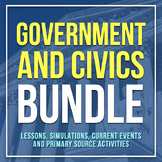Legislative Branch Activity: Classroom Simulation on How a Bill Becomes a Law
- PDF
What educators are saying
Also included in
- This bundle contains every single Civics/Government resource from the Mister Harms store! You're getting every single resource but saving BIG with a whopping 20% OFF all current resources. Once the bundle is yours, you will then get 100% off all future products added to the bundle! Buying the bundlePrice $50.00Original Price $62.50Save $12.50
- What's In This Bundle?This bundle contains access to EVERY single paid resource in the Mister Harms store! Save big and go for it! It's EVERYTHING! It's the whole kit and caboodle, the whole enchilada, the whole ball of wax, the whole shebang! Whatever you want to call it, you're going to get it alPrice $248.68Original Price $355.25Save $106.57
Description
Make civics practical and exciting for students using this Social Studies simulation that allows students to experience the Legislative Branch! Students will participate in writing bills for their school, community, or state while learning the various stages within the lawmaking process. All voices are heard as students become members of Congress, participate in committees, debate on the floor, and watch their President sign the bills that survive the entire process. Not only do students love this simulation, they are actually learning the stages of how a bill becomes a law.
⭐️Save 25% on this product & other civics resources by purchasing the bundle! Click here.⭐️
This Legislative Branch Simulation has become one of the highlights in my government class. Students love the opportunity to write bills in hopes of influencing their school, community, or state. Once a bill has passed through the entire process, many of the students' bills can actually change school policy. Our school has had numerous changes due to my 8th grade bills that became law (water bottle fountains, locker room changes, school course offerings, etc.). Learning about the law-making process is good, but actively being engaged in the process is great!
⭐️See this Legislative Simulation featured on the Teachers Pay Teachers Blog!⭐️
What's Included:
- Now available in Google Drive format!
- Detailed teacher directions explaining how to run the simulation
- Student handout with directions explaining the simulation
- Templates for students to write their own bills (PDF or Google Drive)
- Scoring sheet for student progress (PDF or Editable Google Drive Version)
- Sample bills to help explain how students should write bills
- Everything you need is included! NO PREP! Just print and go!
Additional Content:
I know your students will enjoy this hands-on simulation as you incorporate it within your existing civics and government units. It's a great way to experience the Legislative Branch coming to life for sure! Since this simulation can take some time, I like to break it up by intermittently using my Legislative Branch Notes resource. This set of notes is an excellent way for students to learn additional content and understand how the real Legislative Branch operates! These two "tag-team" resources (the Simulation & the Notes) will help bring variety to the unit as well as reach all learning styles. Together, learning about the Legislative Branch of government will be fun, engaging, and you'll have a complete Legislative Branch unit!! I highly recommend jumping back and forth between this simulation and my Legislative Branch Notes & Worksheet Assessments. Your students will thank you too!
⭐️Click here for more engaging Civics lessons! ⭐️
Thank You!
Thanks so much for stopping by! It's great to meet you! I hope this resource adds value to your classroom. If you have time, I'd love for you to leave a rating on this product with your awesome feedback, and make sure to follow Mister Harms for important updates and savings. I would also love to see how you've incorporated this product into your classroom. Feel free to post a photo of this resource in action and tag @misterharms so I can meet you! I hope you have a wonderful day!
You may also like:
Legislative Branch Notes & Worksheet Assessments
Political Parties Spectrum: What is a Democrat & Republican?
Constitution: Scavenger Hunt, Primary Source
Constitutional Convention Student Notes & Assessment
Class Constitution: Create Your Own Classroom Constitution
CNN 10: News Analysis Graphic Organizers
Roles of the President: A day in the life
Biography Summaries of Historical People Webquests
Declaration of Independence: Primary Source
Constitution: The Articles, Primary Source
Political Parties Presidential Campaign Simulation
Everyday Bell Ringers: Growth Mindset Writing Prompts
Oregon Trail Simulation Lesson
Classonomics: Economic Simulation
Executive Branch Introductory Quiz
Want More?
Stay informed: Join the misterharms.com email list for updates and giveaways!
Follow Mister Harms: TpT | Instagram | Twitter | Pinterest | Facebook







